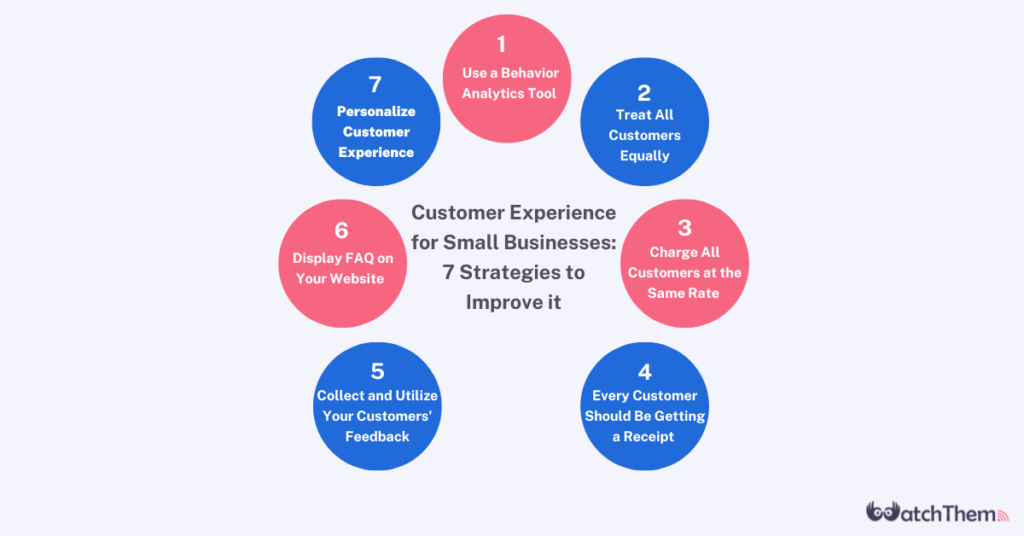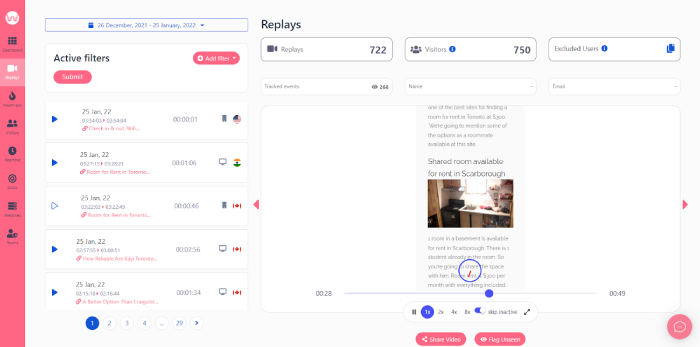Page Contents
Nowadays, we all get used to living with COVID-19. Although COVID-19 impacts small businesses, many of them prospered during this time. Drawing on a survey of more than 5,800 small businesses between March 28 and April 4, 2020, 50% of American workers were employed, while 43% of businesses were temporarily closed. The question is, what made these businesses successful? As far as I remember, customer experience has always been a concern. This has caused competition in today’s marketing world because many businesses believe they provide a ‘superior’ customer experience, but their customers disagree.
In this article, we’ll explain how providing a great customer experience for small businesses is essential and demonstrate seven strategies to improve it.
Note: WatchThemLive is one of the best quick-fix tools that enables you to unlock your customers’ hidden needs and pain points. If you don’t have time to read the whole article, sign up here and snag your free plan.
What Is Customer Experience and Why Is It Important?
As you know, we’re living in a world where small businesses are rising. People are more interested in artisan-made, unique things than massed produced items. As already mentioned, COVID-19 has given way to small businesses because people are looking for the human touch in things. People like supporting small businesses because they know that small businesses probably support somebody’s household or dream. This guide focuses on small business customer experience because people expect more from small businesses and want everything to be perfect. So you need to impress your customers and make them think, ‘WOW.’
According to recent customer experience statistics, 86% of customers are willing to pay more for a superior customer experience. Customer experience refers to the overall impression your customers get from your company throughout all touchpoints in their buying experience. The importance and benefits of customer experience are not deniable. While poor customer experience can repel your customers, a good one can make them return. As a result, they share their experience with their family and friends, and you get more leads.
How Do You Create a Good Customer Experience?
Now, it’s time to introduce 7 strategies for improving customer experience for small businesses:


1. Use a Behavior Analytics Tool
First, always choose the right tools for your business. As a website owner or eCommerce manager, you must understand what satisfies your customers and make the best decision to meet their needs and expectations. A behavior analytics tool helps you keep an eye on your customers’ behaviors on your website to:
- Discover how they interact with your product
- Track their preferences to offer discounts
- Identify their problems and pain points
- Make changes and improve your website’s usability
- Find your website’s weak points
- Remove distractions and increase conversions
- Change your CTAs placement
- Use their interactions to improve your customer service
If you get confused and don’t know which behavior analytics tool is better in today’s marketing world, we’re here to show you the ropes.
WatchThemLive is your only solution to every problem. This behavior analytics tool provides you with all features you need to improve your customer experience. Let’s take a closer look.
1) Heatmaps


WatchThemLive’s website heatmaps allow you to identify whether prospects click on your product page or not and what distracts them from their purchase. You can also see how they interact with product descriptions, photo carousels, etc. with WatchThemLive, you can watch every page separately to see how it works.
Also, you can find out three important matters, including drivers, barriers, and hooks.
2) Session Replay


The session replay tool lets you watch how people browse through your online store to understand their behavioral patterns and optimize their path on your eCommerce website. The exciting part of using WatchThemLive’s session replay is that you can add filters to segment your audience based on their names, emails, screen resolution, devices, etc. So you can follow them through their journey to see what makes them complete their purchases.
2. Treat All Customers Equally
Second, you need to treat all your customers equally, which means not discriminating against your customers. Every company has its own VIP customers; it’s unnecessary to treat them differently, provide their orders with unique and new packaging, or put your business cards in their bags. If you want to, every customer should have that same experience, and you should not be treating one customer above the other because both of them supported your small business no matter how much they paid.
You have no idea how poor packaging can affect your business. Imagine you let some VIP customers order their bag custom while you use some Walmart gift bags for others. Apart from the fact that it’s not professional, it’s unacceptable, especially for the prices people pay. Furthermore, if one of your customers figures this out, you can quickly lose them. You need to make customers feel valued, so you should think about everything before starting a business.
3. Charge All Customers at the Same Rate
Third, you need to keep everyone at the same rates. You must not charge somebody else less because they don’t have enough money to pay. The reason is when you’re charging different prices for the same item, and somebody paid more, that’s insulting, and they will not support you again if they become aware of it.
4. Every Customer Should Be Getting a Receipt
Fourth, providing your customers with receipts not only helps you build your customers’ trust but also enables you to be sure that there is no mistake in their orders. It also permits budget management to keep track of your spending.
5. Collect and Utilize Your Customers’ Feedback
Fifth, social media plays an essential role in our lives today. People are not afraid of sharing their bad experiences on Instagram or Facebook. So instead of blocking and reporting those customers or deleting their negative comments, try to listen to them and solve their problems. Besides social media channels, you can collect customer feedback through surveys, case studies, reviews, and polls.
6. Display FAQ on Your Website
Sixth, professionalism sets the expectation for your customers. So if you have a website, you can use the FAQs section and answer all possible questions customers may ask to improve their buying journeys. It also helps you save money on customer service and quickly address new customer service issues.
7. Personalized Customer Experience
Seventh, personalized customer experience is one of the helpful strategies you can use to build your brand loyalty and increase your customer satisfaction. First, you need to look at your current customer experience map. Then, you need to identify the high-conversion group of your customers versus the low-conversion group of customers to understand what makes them abandon their carts. Finally, you can answer their emails and questions to ensure they have a good experience with your company.
Conclusion
In this article, we tried to explain seven strategies to improve customer experience for small businesses. How your customers feel when they get their orders significantly impacts customer retention. Meanwhile, make sure to register on WatchThemLive to improve your website and get better results.


